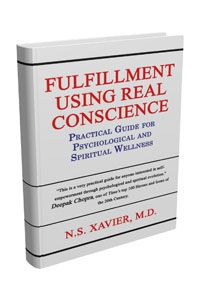Publication
Article
Psychiatric Times
Fulfillment Using Real Conscience: Practical Guide for Psychological and Spiritual Wellness
The ancient role of conscience as a moral pilot is rejuvenated, and its neglected function as a spiritual daemon is refurbished for more psychologically minded modern readers.
The image of conscience in medicine has been tarnished of late, owing to its association with refusals of certain forms of treatment based on presumptive value judgments.1 In this book, the ancient role of conscience as a moral pilot is rejuvenated, and its neglected function as a spiritual daemon is refurbished for more psychologically minded modern readers.
The present volume is a modified and expanded version of the author’s earlier work, Fulfilling Heart and Soul, and also echoes themes in his previous book, The Two Faces of Religion. Author N. S. Xavier, MD, is a practicing psychiatrist with a deep knowledge of “wisdom traditions,” as expressed in literature, religion, philosophy, and history. He brings both his scientific and humanistic backgrounds to this practical, easy-to-read-and-apply handbook for spiritual and moral growth.
The core insight of the book is the difference between real conscience-which uses reason and the Golden Rule to make choices-and the superego-which is socially programmed and prone to depart from the dictates of true conscience. In Dr Xavier’s view, this results in much of the pathos and pathology that afflict our culture and species. Xavier describes conscience as “motivated by love, compassion or fairness, and guided by reason with an open mind, [thus promoting] what is useful for oneself and others.” The author links this thesis in 13 chapters to what he calls “deeply felt human needs” for esteem, identity, relationships, power, sexuality, and meaning, along with the necessity of integrating the past with the present and the future.
Academics in the humanities may feel there is a lack of rigor in the scholarship of the book. For instance, there is no intellectual history of the idea of conscience as a concept. However, we need to keep in mind the author’s intention to transform and represent these too often inaccessible insights into practical companions for ordinary people, struggling to live healthy and good lives.
The book is conversational in tone and lives up to its name as a “guide,” providing lists, memorable acronyms (eg, “PIG” for problem of irrational gratification), quotations, clinical anecdotes, and literary stories. The appendix presents basic meditation techniques and illustrates how individuals with addictions and DSM-IV-TR personality disorders can be understood as having deficits of and conflicts between the real conscience and the superego.
Clergy, counselors and other mental health professionals, and patients with religious orientations-especially Christians-will find this a more comfortable alternative to many similar secular books. Ironically, some people may have questions of conscience about the book, particularly regarding the chapter on sexual ethics and the appeal to the Catholic Church.
Some may also find the author’s approach to the resolution of profound psychic suffering (as described in a number of vignettes) to be paternalistic and reductionistic. Other readers will find the recommendation that the pathway to peace-for individuals and society-lies in following the conscience that Vincent Van Gogh called “man’s compass.”






